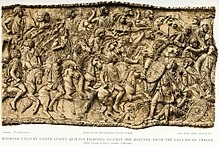| Some of this article's listed sources may not be reliable. Please help improve this article by looking for better, more reliable sources. Unreliable citations may be challenged and removed. (December 2023) (Learn how and when to remove this message) |

Numidian cavalry was a type of light cavalry developed by the Numidians. They were used by Hannibal during the Second Punic War.
History

Numidian cavalry is first mentioned by Polybius as part of the Carthaginian army during the First Punic War.
The Numidian cavalry's horses, ancestors of the Berber horse, were small compared with other horses of the era, and were well adapted for faster movement over long distances. Numidian horsemen rode without saddles or bridles, controlling their mounts with a simple rope around their horse's neck and a small riding stick. They had no form of bodily protection except for a round leather shield or a leopard skin, and their main weapons were javelins in addition to a short sword.
Due to their expert horsemanship and agility, as well as their lack of armor or heavy weaponry, they were most suitable for harassing tactics, charging in loose formation and lobbing their javelins before wheeling off to escape the enemy's counterattack. This harassing tactic, while rarely decisive, could be extremely frustrating to a less mobile enemy, as experienced by Julius Caesar's soldiers during the latter's invasion of Africa.
The Numidians were extremely useful during small wars, and their presence certainly contributed greatly to the effectiveness of Hannibal's reconnaissance and intelligence. Hannibal's invasion of Rome during the Second Punic War is best known for his extremely limited use of slow-moving war elephants, but he also employed Numidian cavalry where faster movement was needed, such as luring the Romans into a trap at the Battle of Trebia and for fighting on his right flank.
Numidian cavalry were widely known and not only fought in the Carthaginian army, but in other armies of the time as well. Again during the Second Punic War, the Romans allied with the Numidian king Masinissa who led 6000 horsemen against Hannibal's own in the battle of Zama, where the "Numidian Cavalry turned the scales".
For centuries thereafter, the Roman army employed Numidian light cavalry in separate units (equites Numidarum or Maurorum).
The Numidian cavalry were also used in Caesar's civil war on the side of Pompey and were used in Battle of Utica.
Second Punic War (218–201 BC)


Throughout the war, Numidian cavalry continued to harass Roman forces, disrupting their supply lines and communications. Their presence forced the Romans to adopt a more cautious approach, hindering their ability to maneuver freely and engage in decisive battles.
The Numidians' impact extended beyond the battlefield. Their knowledge of the terrain and local customs proved invaluable to Hannibal as he navigated the unfamiliar landscape of Italy. They served as guides, scouts, and intermediaries, helping the Carthaginian army adapt to its new surroundings and establish alliances with local tribes.
While the Numidian cavalry did not engage in direct frontal assaults against Roman infantry, their indirect contributions to the Carthaginian cause were immense. Their ability to disrupt Roman supply lines, gather intelligence, and exploit terrain advantages played a significant role in Hannibal's early successes in Italy.
Despite their remarkable feats, the Numidians' contributions to the Second Punic War often go overlooked, overshadowed by the more prominent roles played by Roman and Carthaginian infantry and commanders. Nevertheless, their impact on the war was undeniable, and their legacy as masters of cavalry warfare endures to this day. The Numidian horsemen stand as a testament to the power of adaptation, resilience, and tactical ingenuity, demonstrating that even in the face of overwhelming odds, smaller forces can make a significant impact on the course of history.
Carthaginian Numidian cavalry

The Carthaginians initially relied heavily on Numidian cavalry, particularly during the early stages of the war. Their skilled horsemanship and familiarity with the North African terrain proved valuable in scouting, harassing Roman supply lines, and engaging in skirmishes. However, as the war progressed and the Romans gained control of key territories, the Carthaginians' access to Numidian reinforcements dwindled.
Roman Numidian cavalry
See also: Auxilia
The Romans also employed Numidian cavalry, primarily drawn from conquered territories or allied tribes. These horsemen served a similar purpose to their Carthaginian counterparts, providing reconnaissance, disrupting enemy movements, and engaging in light cavalry engagements. Roman commanders appreciated the Numidians' adaptability and effectiveness in open terrain, often deploying them as a complement to their heavier infantry formations.
See also
- Military of Carthage
- Jinete, a similar medieval military unit in Al Andalus that originated from the Zenata Imazighen
References
- Horsted, William (2021). The Numidians 300 BC–AD 300. Bloomsbury Publishing. pp. 3–10. ISBN 9781472842176.
- Epona Archived 2008-03-18 at the Wayback Machine
- RedRampant.com
- Invasion of Italy
- Sidnell, Philip. Warhorse: Cavalry in Ancient Warfare, p.194.
- Fuller, J.F.C., Julius Caesar: Man, Soldier, and Tyrant. p. 28 ISBN 0-306-80422-0
- Daly, Gregory (2005-08-18). Cannae: The Experience of Battle in the Second Punic War: The Experience of Battle in the Second Punic War. Routledge. ISBN 978-1-134-50711-5.
- Mancini, John (2009-02-27). Defending the Roman Republic: Ending the 2Nd Punic War. iUniverse. ISBN 978-0-595-61779-1.
- Taylor, George (2022-07-29). The Numidian History: The Ancient Berbers Of Numidia And Carthage In The Shadow Of Rome. Amazon Digital Services LLC - Kdp. ISBN 979-8-8429-8744-3.
- Smith, R. Bosworth (2018-04-13). The Punic Wars. Ozymandias Press. ISBN 978-1-5312-7944-8.
- Horsted, William (2021-01-26). The Numidians 300 BC–AD 300. Bloomsbury USA. ISBN 978-1-4728-4219-0.
- McCall, Jeremiah B. (2005-06-29). The Cavalry of the Roman Republic. Routledge. ISBN 978-1-134-51818-0.